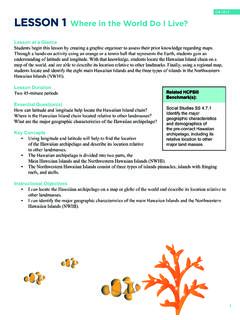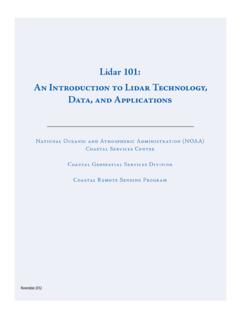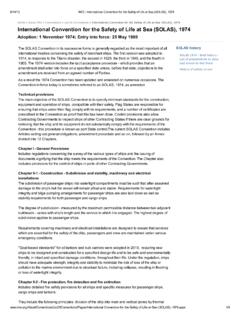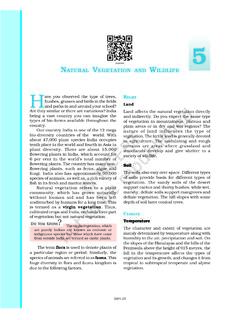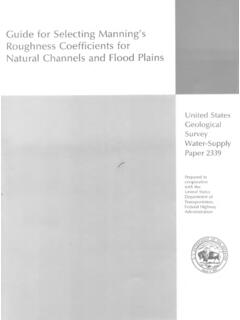Transcription of Natural and Structural Measures for Shoreline Stabilization
1 Natural and Structural Measures for Shoreline StabilizationLiving ShorelinesInnovative approaches are necessary as our coastal communities and shorelines are facing escalating risks from more powerful storms, accelerated sea-level rise, and changing precipitation patterns that can result in dramatic economic losses. While the threats of these events may be inevitable, understanding how to adapt to the impact is important as we explore how solutions will ensure the resilience of our coastal communities and brochure presents a continuum of green to gray Shoreline Stabilization techniques, highlighting Living shorelines , that help reduce coastal risks and improve resiliency though an integrated approach that draws from the full array of coastal risk reduction Risk Reduction and Living ShorelinesIn order to determine the most appropriate Shoreline protection technique, several site-specific conditions must be assessed.
2 The following coastal conditions, along with other factors, are used to determine the combinations of green and gray solutions for a particular : A longshore segment of a Shoreline where influences and impacts, such as wind direction, wave energy, littoral transport, etc. mutually : The ability to avoid, minimize, withstand, and recover from the effects of adversity, whether Natural or man made, under all circumstances of use. This definition also applies to engineering (i), ecological (ii), and community resilience (iii).Fetch: A cross shore distance along open water over which wind blows to generate waves. For any given shore, there may be several fetch distances depending on predominant wind conditions: The slope of the foreshore or beach face, a geologic condition or bathymetry Range: The vertical difference between high tide and low suRge: The resulting temporary rise in sea level due to the action of wind stress on the water surface and low atmospheric pressure created during storms which can cause coastal flooding.
3 Surge is the difference from expected tide level. Storm tide is the total water eneRgy: Wave energy is related to wave height and describes the force a wave is likely to have on a Shoreline . Different environments will have lower or higher wave energy depending on environmental factors like shore orientation, wind, channel width, and bathymetry. Boat wakes can also generate : Limited fetch in a sheltered, shallow or small water body (estuary, river, bay) < 2 : A range that combines elements of low and high energy ( , shallow water with a large fetch or partially sheltered) 2 - 5 : Large fetch, deep water (open ocean).High Water LevelLow Water LevelStorm TideTidal RangeReachFetchStorm Surges at Low & High TideCoastal Risk ReductionCoastal systems typically include both Natural habitats and man-made Structural features.
4 The relationships and interactions among these features are important variables in determining coastal vulnerability, reliability, risk and resilience. Coastal risk reduction can be achieved through several approaches, which may be used in combination with each other. Options for coastal risk reduction include: Natural or nature-based Measures : Natural features are created through the action of physical, biological, geologic, and chemical processes operating in nature, and include marshes, dunes and oyster reefs. Nature-based features are created by human design, engineering, and construction to mimic nature. A living Shoreline is an example of a nature-based feature. Structural Measures : Structural Measures include sea walls, groins and breakwaters. These features reduce coastal risks by decreasing Shoreline erosion, wave damage, and flooding.
5 Non- Structural Measures : Includes modifications in public policy, management practices, regulatory policy and pricing policy ( , structure acquisitions or relocations, flood proofing of structures, implementing flood warning systems, flood preparedness planning, establishment of land use regulations, emergency response plans).The types of risk reduction Measures employed depend upon the geophysical setting, the desired level of risk reduction, objectives, cost, reliability, and other Systems Approach to Geomorphic EngineeringUSACE and NOAA recognize the value of an integrated approach to risk reduction through the incorporation of Natural and nature-based features in addition to non- Structural and Structural Measures to improve social, economic, and ecosystem resilience. To promote this approach, USACE and NOAA have engaged partners and stakeholders in a community of practice called SAGE, or a Systems Approach to Geomorphic Engineering.
6 This community of practice provides a forum to discuss science and policy that can support and advance a systems approach to implementing risk reduction Measures that both sustain a healthy environment and create a resilient promotes a hybrid engineering approach that integrates soft or green Natural and nature-based Measures , with hard or gray Structural ones at the landscape scale. These Stabilization solutions include living Shoreline approaches which integrate living components, such as plantings, with Structural techniques, such as seawalls or shorelines achieve multiple goals, such as: Stabilizing the Shoreline and reducing current rates of Shoreline erosion and storm damage; Providing ecosystem services (such as habitat for fish and other aquatic species) and increasing flood storage capacity; and Maintaining connections between land and water ecosystems to enhance NourishmeNt o Nlylarge volume of sand added from outside source to an eroding beach.
7 Widens the beach and moves the Shoreline Forlow-lying oceanfront areas with existing sources of sand and options sandBenefits expands usable beach area lower environmental impact than hard structures Flexible strategy Redesigned with relative ease Provides habitat and ecosystem servicesDisadvantages Requires continual sand resources for renourishment no high water protection appropriate in limited situations Possible impacts to regional sediment transportsillsParallel to existing or vegetated Shoreline , reduces wave energy and prevents erosion. a gapped approach would allow habitat connectivity, greater tidal exchange, and better waterfront Formost areas except high wave energy * Base with material options stone sand breakwaters living reef (oyster/mussel) Rock gabion basketsBenefits Provides habitat and ecosystem services dissipates wave energy slows inland water transfer Provides habitat and ecosystem services increases Natural storm water infiltration toe protection helps prevent wetland edge loss Disadvantages Require more land area no high water protection uncertainty of successful vegetation growth and competition with invasiveeDgiNgstructure to hold the toe of existing or vegetated slope in place.
8 Protects against Shoreline Formost areas except high wave energy * Base with material options(low wave only, temporary) s now fencing erosion control blankets geotextile tubes living reef (oyster/mussel) Rock gabion basketsBenefits dissipates wave energy slows inland water transfer Provides habitat and ecosystem services increases Natural storm water infiltration toe protection helps prevent wetland edge lossDisadvantages no high water protection uncertainty of successful vegetation growth and competition with invasiveVegetatioN o NlyRoots hold soil in place to reduce erosion. Provides a buffer to upland areas and breaks small Forlow wave energy options native plants*Benefits dissipates wave energy slows inland water transfer increases Natural storm water infiltration Provides habitat and ecosystem services minimal impact to Natural community and ecosystem processes maintains aquatic/terrestrial interface and connectivity Flood water storageDisadvantages no storm surge reduction ability no high water protection appropriate in limited situations uncertainty of successful vegetation growth and competition with invasiveLIvING S hoRELINE initial construction: operations & maintenance: initial construction: operations & maintenance: initial construction: operations & maintenance: initial construction: operations & maintenance.
9 HoW GREEN oR G R Ay ShouLd youR Shoreline SoLutIoN bE?GREEN - SoFtER tEChNIquESsmall Waves | small Fetch | gentle slope | sheltered coast* native plants and materials must be appropriate for current salinity and site construction: = up to $1000 per linear foot, = $1001 - $2000 per linear foot, = $2001 - $5000 per linear foot, = $5001 - $10,000 per linear footoperations and maintenance (yearly for a 50 year project life): = up to $100 per linear foot, = $101 - $500 per linear foot, = over $500 per linear footPhoto Credit: Maryland Department of Natural Resources - Shoreline Conservation ServicePhoto Credit: Maryland Department of Natural Resources - Shoreline Conservation ServicePhoto Credit: Partnership for Delaware EstuaryBre ak waterOffshore structures intended to break waves, reducing the force of wave action and encourages sediment accretion.
10 Can be floating or fixed to the ocean floor, attached to shore or not, and continuous or segmented. a gapped approach would allow habitat connectivity, greater tidal exchange, and better waterfront Formost areas except high wave energy environments often in conjunction with options Grout-filled fabric bags Wood Armorstone Rock Pre-cast concrete blocks living reef (oyster/mussel) if low wave environmentBenefits Reduces wave force and height stabilizes wetland can function like reef economical in shallow areas Limited storm surge flood level reductionDisadvantages expensive in deep water can reduce water circulation (minimized if floating breakwater is applied) can create navigational hazard Require more land area uncertainty of successful vegetation growth and competition with invasive no high water protection can reduce water circulation can create navigation hazardgroiN Perpendicular, projecting from Shoreline .
